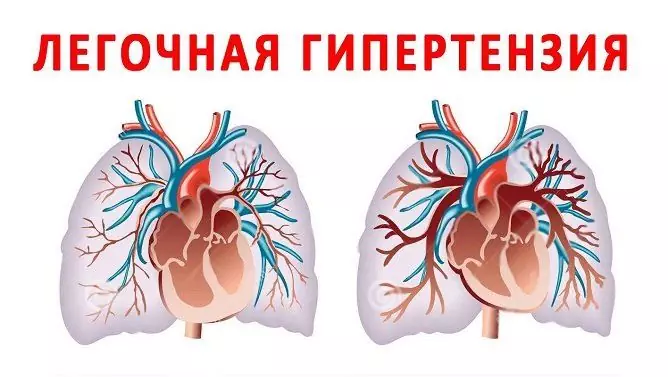- Author Rachel Wainwright [email protected].
- Public 2023-12-15 07:39.
- Last modified 2025-11-02 20:14.
Pulmonary hypertension: symptoms, stages, prognosis
The content of the article:
- Etiology and pathogenesis
- Classification
- Pulmonary hypertension symptoms and diagnosis
- Pulmonary hypertension treatment
- Forecast
- Video
Pulmonary hypertension (PH) is a pathological condition in which the pressure in the pulmonary circulation is critically increased, which leads to systemic circulatory disorders, right ventricular failure, pulmonary edema and concomitant respiratory failure. Since the pathology affects the great vessels, it always has a massive effect on the body. The clinical picture in different patients may differ, but there are always clear signs of respiratory failure - chest discomfort, shortness of breath, cough.

Increased pressure in the pulmonary circulation is usually caused by heart or lung disease
The disease is almost always secondary, that is, it develops as a consequence or complication of the primary diagnosis. In rare cases, the syndrome of hypertension in the pulmonary circulation occurs as an independent pathology of uncertain etiology, then they talk about idiopathic hypertension. The condition can develop both acutely, then it can be classified as terminal or chronically. The second type is more favorable in terms of prognosis.
Etiology and pathogenesis
What is pulmonary hypertension and why does it occur? The disease is polyetiological, that is, it is caused by many reasons, one way or another leading to an increase in pressure in the vessels of the pulmonary circulation - the pulmonary trunk, pulmonary veins and arteries, the microvasculature of the lung parenchyma, and also in the right ventricle of the heart.
Speaking of secondary hypertension, which arises as a complication of the underlying disease, heart defects, both congenital and acquired, are called as the main causes: mitral stenosis and mitral valve insufficiency, stenosis or insufficiency of the tricuspid valve, defects of the semilunar valve apparatus, atrial or interventricular defect partitions - non-closure of the oval opening.
One of the common causes is heart failure, acquired as a result of a heart attack, when the pumping function of the heart muscle can no longer adequately correlate with the resistance of the peripheral muscles. This leads to stagnant processes in the chambers of the heart, and arterial and pulmonary pressure increase. Inflammatory heart diseases, including those caused by a heart attack, that is, myocarditis, endocarditis, inflammation of the bursa, can lead to similar consequences. They reduce the contractile force of the myocardium.

Shortness of breath - the main symptom of hypertension in the pulmonary circulation
Circulatory disorders in a small circle can occur as a result of organ failure, in particular, hepatic (pathogenetically, this chain extends from portal hypertension) and renal (since the kidneys control the volume of circulating blood and lower, diastolic blood pressure). Hypoventilation of the lungs, hypoxic conditions, such as high-altitude hypoxia, also lead to hypertension. Actually pulmonary diseases lead to an increase in pressure in the lungs due to deterioration of patency, i.e. obstruction.
Chronic hypertension is often caused by inflammatory diseases of the lung parenchyma, in particular, pneumonia, as well as diffuse connective tissue diseases.
Acute PH is the most dangerous, it occurs due to acute left ventricular failure, thrombosis in the pulmonary artery system (PE - pulmonary embolism, although depending on the size of the blocked vessel, chronic thromboembolic hypertension can also develop), as well as respiratory distress syndrome and status asthma …
Primary pulmonary hypertension is genetically determined and is associated with mutations in a number of genes that are transmitted in an autosomal dominant manner. It is often impossible to say exactly which of the inherited mutations leads to this disease. The likelihood of PH is assessed as high if the patient has hemolytic anemia or is HIV-positive.
The mechanism of development of the disease is complex and consists of many links, the main ones being an increase in pulmonary venous pressure and an increase in pulmonary vascular resistance.
The first condition is caused by an increase in pressure in the left side of the heart, which causes high pressure in the pulmonary veins. This is due to obstruction or obliteration of the lumen of blood vessels, stagnant processes, hyperextension of the heart wall. High pressure leads to the activation of compensatory mechanisms, after which the body begins to adapt to the prevailing conditions - it provokes a thickening of the walls of blood vessels until they can create sufficient resistance to the increased pressure. The same process is observed in the capillaries of the lungs, which become full-blooded, swollen.
Changes in the vessel walls lead to increased pulmonary vascular resistance. This means that the perfusion of gases through the hypertrophied vascular wall (in particular, the endothelium and smooth muscle fibers) is impaired. This, in turn, increases the pressure in the alveoli. This is how the mechanism of respiratory failure is formed.
Classification
PH was assigned the code according to ICD 10 (International Classification of Diseases in the 10th edition) I27 with the identifier "Other forms of pulmonary heart failure". Depending on the pathogenetic factor that led to its development, the following types of hypertension in the pulmonary circulation are distinguished:
- Pulmonary arterial hypertension (PAH), which, in turn, is divided into idiopathic, hereditary, and also associated with each of the above etiological factors (if it is secondary hypertension). PAH caused by drug intake or intoxication is isolated separately.
- Pulmonary capillary hemangiomatosis.
- Persistent pulmonary hypertension in newborns.
- Associated with damage to the left heart - systolic or diastolic dysfunction, valvular (valve) disorders, congenital cardiopathy.
- Associated with lung disease and hypoxia - due to hypoventilation, COPD (chronic obstructive pulmonary disease), interstitial diseases, sleep apnea and other hypoxic conditions.
- Chronic thromboembolic disease due to tumors, foreign bodies, parasitic invasion, pulmonary embolism.
- Multifactorial - associated with hemolytic anemia, storage diseases, fermentopathies, sarcoidosis, renal hypertension.
A clinical classification is also used depending on the recorded pressure and clinical manifestations, which will be considered together with the symptoms.
Pulmonary hypertension symptoms and diagnosis
There are several methods that are used in the clinic to measure the level of pressure in the right side of the heart. The main ones are the invasive method of cardiac catheterization and non-invasive echocardiography. Catheterization provides the most accurate results, but is used less frequently because of the associated risks. Also, chest x-ray, ECG, spirometry (breath tests) are performed.
To determine the functional class of LH, a 6-minute walk on a treadmill is prescribed under the strict supervision of a doctor and resuscitator.

One of the methods for diagnosing PH is a chest x-ray
A biochemical blood test can indicate pathology in the heart muscle.
Depending on the actual level of pressure, three degrees of the disease are distinguished:
- Stage 1 - the pressure is 25-45 mm Hg. Art.;
- Grade 2 - pressure 45-65 mm Hg. Art.;
- Grade 3 - pressure over 65 mm Hg. Art.
The higher the pressure level and the longer the time from the manifestation of pathology, the more pronounced the symptoms of the disease. Depending on the clinical picture, four classes of hypertension are distinguished, each of which differs in the volume of treatment.
- Pathology can be detected only during instrumental studies, and there are practically no clinical signs of the disease. This is due to the compensation of respiratory and cardiac activity, but it is limited by the body's resources.
- At this stage, the first symptoms appear, they appear during physical exertion or active movement. The patient experiences chest pain or discomfort, shortness of breath, feeling short of breath, dizziness.
- It is accompanied by functional impairments even at rest. Weakness, dizziness, shortness of breath, and apnea can occur even after minor exertion, such as walking short distances. This condition requires hospitalization.
- A threatening state of respiratory failure that does not disappear at rest and during sleep. Massive pulmonary edema develops, a wet cough is possible, which eventually turns into hemoptysis.
Also PH is usually accompanied by symptoms of primary pathology.
Pulmonary hypertension treatment
Treatment consists in a comprehensive therapeutic approach to the primary disease, as well as in lowering total blood pressure and pressure in the pulmonary artery in particular. For this, pharmacological drugs are usually used, but in some cases, surgical intervention may be required.
To compensate for hypoxic conditions, bronchodilators and oxygen therapy are prescribed, and to prevent endothelial transformation for medical reasons, phosphodieterase inhibitors and endothelin receptor blockers are taken.
How is primary hypertension treated? The main link in pathogenesis - high blood pressure - is stopped by vasodilators (vasodilators), which are effective at first, but after the appearance of pronounced obturation, they lose their effectiveness. In the later stages, diuretics are used, achieving forced diuresis, which helps to reduce the volume of circulating blood.
Calcium channel blockers are used, which also reduce blood pressure, cardiac output and normalize hemodynamics.

PH patients require medical supervision
For the prevention of thromboembolic complications, antiplatelet agents and anticoagulants are prescribed. They are also included in the list of drugs for the treatment of pulmonary embolism. For health reasons, excision of a thrombus can be performed.
Forecast
The answer to the question "how long do they live with this?" depends on the time that the patient spent in a state of progressive hypertension, compensatory capabilities of the body, general resistance, age (PH is especially dangerous in children, as in women during pregnancy), primary disease. Seeking medical attention in a timely manner improves survival.
Primary hypertension has a less favorable prognosis and requires constant pharmacological correction. Complications are dangerous in the long term.
Moderate hypertension can be relieved by several groups of drugs throughout life, while the patient is advised to refrain from physical activity, normalize the daily routine and diet, and regularly visit a cardiologist and pulmonologist for routine examination. It is possible to resort to folk remedies only in the form of prevention - it is ineffective to treat LH with such methods.
Video
We offer for viewing a video on the topic of the article.

Nikita Gaidukov About the author
Education: 4th year student of the Faculty of Medicine No. 1, specializing in General Medicine, Vinnitsa National Medical University. N. I. Pirogov.
Work experience: Nurse of the cardiology department of the Tyachiv Regional Hospital No. 1, geneticist / molecular biologist in the Polymerase Chain Reaction Laboratory at VNMU named after N. I. Pirogov.
The information is generalized and provided for informational purposes only. At the first sign of illness, see your doctor. Self-medication is hazardous to health!






